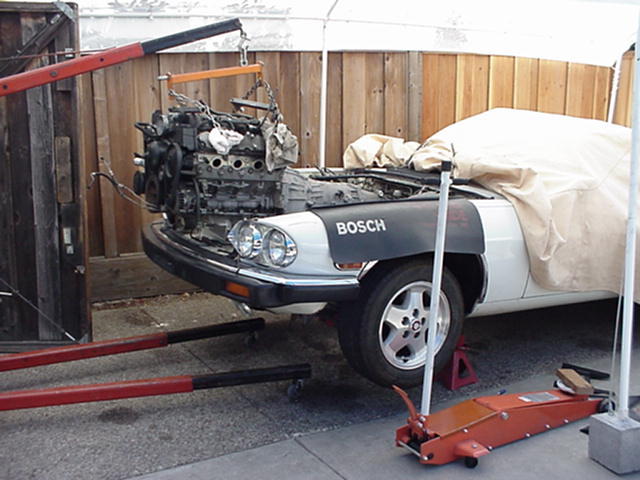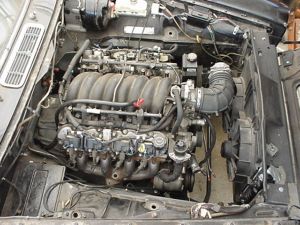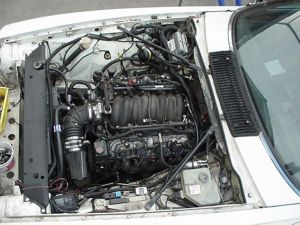
Telephone: 408-839-5569
Email: (Click Here) Andrew@JaguarSpecialties.com
Last Update 7-2-24
XJ6 and XJS LS Engine Conversions- LS1 LS2 LS3 LS6 LS7Note to readers: Kits are now available for LS engine conversions into 70-87 XJ6 (sedan and coupe) and 76-96 XJS cars. These articles are here to give you a flavor for what's involved in doing an LS engine conversion on your Jaguar, and I will be adding more on the different aspects of the projects from time to time. After driving my (finished) LS1-Jaguars for a while now, I can attest that the power, torque, flexibilty, and smooth reving of these engines are a perfect match these cars. This is a fantastic conversion opportunity any XJ6 or XJS, and with the information in our conversion manual, and the kit and supporting parts, a Jag owner could do this conversion on his own car easily. I hope you enjoy the different installments- please feel free to Email or call with questions, etc.,.
Part 2 It’s now been several months since my first installment on the XJ6C LS1 conversion, and a lot has happened since then. The biggest development is that I added another car to the conversion plan- an ‘89 XJS convertible. I had always planned to do one of these anyway, and since the floor pans of an XJS and XJ6 coupe/sedan are so similar, doing these 2 cars at once really isn’t double the work. So the XJS was stripped of its V12 engine/trans and the work began, with the 2 cars side by side. In both cases the donor cars were 98 Camaro Z28’s with the LS1/automatic power trains, a configuration that will likely cover 95% of the conversions done on Jaguars. But keep in mind that the T56 (6-speed) manual trans also used behind the LS1 is nearly identical to the T56 used behind the LT1 in my 88 XJSC, so a manual trans LSx powered Jag is an option (contact me for more info....) Again, the objective of this project is to develop a kit and supports parts that could be used by any customer to do an LS1 (or any LSx engine) conversion on any 70-87 XJ6 sedan or coupe, or any XJS. First fit and problem areas- LSx engines are of course a completely new variety of Chevy small block, and little (if any) information or conversion data from the older engines applied to them. Overall the LS is somewhat wider than the older small blocks, but that doesn’t seem to be a problem in a Jag, as it is still narrower than a V12. The first fits into both the XJ6C and XJS were pretty straightforward, but it was obvious the oil pan area needed attention. LSx series oil pans are all heavy cast aluminum, designed to add some rigidity to the block. Each GM installation uses a unique oil pan design, with a variety of different configurations. I investigated (without exaggeration) at least a dozen different pan designs, some OE GM, and some aftermarket, and despite the varied shapes, nothing easily fits the Jag chassis. Similarly, it was clear that the older style Jaguar-GM conversion mount adaptors were close, but would not work with the LSx. Lastly, I wanted to use an OE GM front accessory drive (and stay away from expensive aftermarket hardware) and that required the engine/trans to be positioned slightly higher in the Jag chassis. That AC compressor very low on the right was the killer. But it was accommodated and doing so will keep overall costs of the conversion low, and reliability high. Another objective was to try an use OE GM exhaust manifolds and stay away from custom headers. Like earlier conversions, the driver side/steering shaft area is a tight, but one or more of a variety In the end, the final positioning of the engine/trans was well inside the alignment requirements with the differential (within 0-2 degrees), and there was still sufficient clearance all around without major “ballpeen bodywork” of the engine compartments or trans tunnels. Any slight reconfiguring was minimal, and very similar to previous conversions. Here is a pic of the project XJS swallowing an LS1 for the first time.....
Oil Pan- In the end, there really is no standard OE GM oil pan that will fit the Jag chassis/crossmember without any modification and provide adequate ground clearance. The GM truck and Hummer oil pans with their extreme rearward sump would clear the crossmember, but hung 2-3 inches below it, so no ground clearance there. The Cadillac CTS-V uses a pan with a profile most like the (stamped steel) pans on earlier GM engines, but the shape did not quite fit, and again ground clearance was a problem (surprising as this comes from a relatively low car overall- they must have the engine mounted pretty high in the CTS). Corvette pans would have been the most attractive with their superior oil control and ground clearance, but their wild shapes (extreme widths and long sump) didn’t cut it. There are several different sources for modified LSx aluminum pans out there- however some of the mods done are significant (including extending the oil pickup- something that makes me queasy), and they usually reduce overall oil capacity. None of those seemed like good options. Ultimately, we found a pan that would work, and work well for our application. Although this pan does require some modification for use in our Jags, the final combination of overall fit, good ground clearance, the ability to use a stock oil pickup, and a negligible loss of oil capacity made the required (relatively minor) mods acceptable. These modifications have been carefully detailed, and should be easy for any end user to duplicate locally. Attached are a few pics of the oil pan test fits- first photo is the Cadillac pan-notice it drops below the crossmember on the right and also below the lower edge of the bellhousing on the left. The next photo is the final design modified standard GM pan- not really lower than the crossmember on the left, and in line with the bellhousing to the right.
Engine and transmission mounts- As mentioned above, the old design engine and trans mounts were close to what might work for an LSx, but not close enough to use. The required higher engine positioning and changes to the 4L60E (2nd generation) tail housing area (where we typically bolted on the rubber isolator on the T700R4 or first gen 4L60E) required a redesign of the engine and trans mount adaptors. The final designs are all bolt-in pieces requiring no drilling, welding, or cutting on the Jag body or crossmember, and use the same Chevy engine and trans rubber isolators as earlier conversions. They are simple rugged pieces that install easily, offer some adjustment, and provide good access to other local components. The mount set designed here also allows the user to run the stock Camaro accessory drive system (including the low mount AC compressor) so there is no need for expensive aftermarket drive systems- just good old reliable OE GM. Here are couple of pics of the engines situated in both the XJ6C and XJS- they're both a really good fit.
Driveline- The second generation 4L60E (different from the earlier 4L60E in that it has a detachable solid bellhousing and other improvements) actually still shares the same output shaft diameter and spline count as the earlier transmissions. As a result, the only real difference between driveshafts built for the LSx-Jag conversions and those using earlier Chevy engines, is the overall length. The drivetrain is positioned slightly rearward on these conversions, so the driveshafts themselves are just slightly shorter than before. Otherwise, the front yoke size/type, U-joint size, and the tube diameter are the same as before. Coming in Part 3- Cooling system, basic wiring, and exhaust
|




